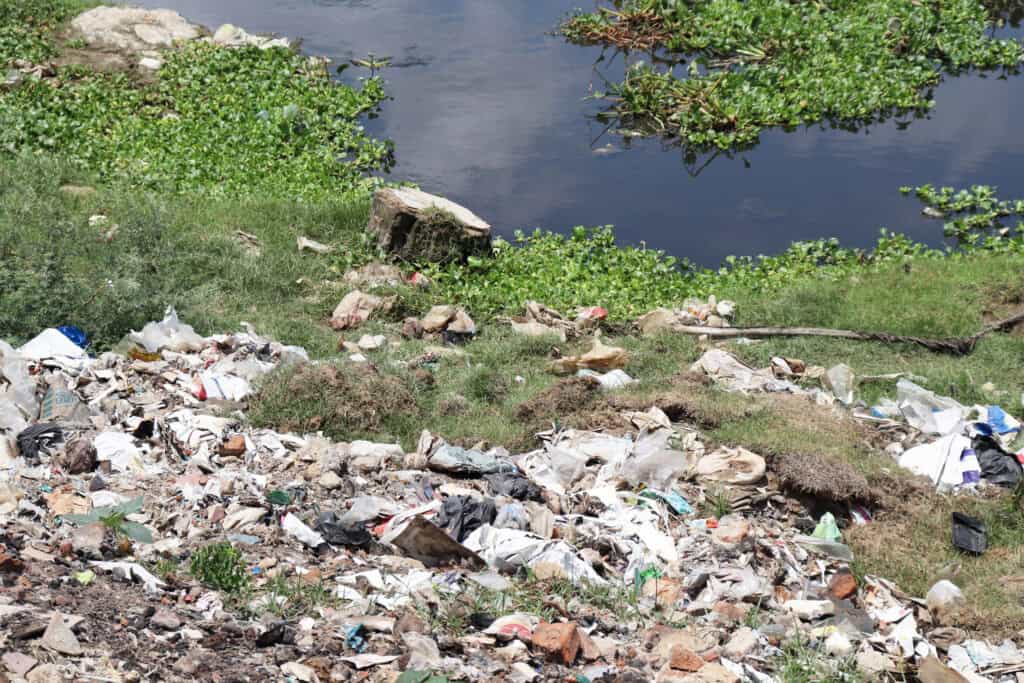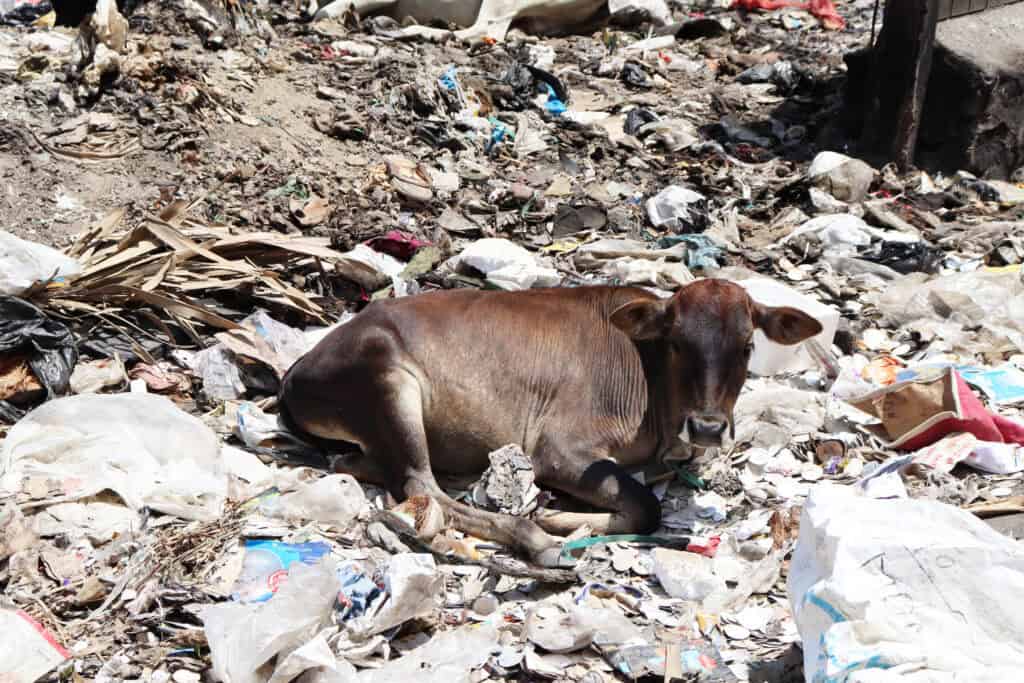Indira Nagar, Gerugambakkam is a suburb bordering Chennai that lies on the banks of the Adyar river. The area is a stark example of the city’s failure to do well by its natural resources, and many residents are vocal in their unhappiness about the condition of the Adyar. The riverbank is full of non-biodegradable trash and decomposing waste. A putrid smell permeates the air, making it hard for residents and passers-by to breathe. In addition to waste, the river also receives untreated sewage on a daily basis. The water hardly flows, save for when it rains. The bank looks much like a dumpyard, with heaps of unsegregated trash strewn around. There are multiple burn patches on the ground, too – these are the result of attempts to burn the waste.
A significant portion of the waste being dumped into this part of the river reportedly comes from sources outside the local community, such as the airport compound and Cowl Bazaar. Mr. Kasi, a ward member, gave the example of an electric company from Pallavaram that he says used to dump and burn their waste near the river. “The only solution to stop waste from being dumped in the river is to build a compound wall throughout the river stretch,” says Mr Palani, a lorry driver. “The government should do it.” Adds Mr. Kasi, “People are suffering from malaria and dengue in our area because of the mosquito breeding that arises from the dumped waste.”

From lifeline to landfill: The tragic transformation of Adyar River.
Ravi, an auto-driver, says that a leather factory in Nagalkeni which was once shut down has resumed operations and is dumping both physical and chemical wastes into the river. He also expressed his concerns about the sewage system under construction. “The sewage from this system will ultimately be released into the Adyar river because there is nowhere else for it to go. It will ultimately make the river’s condition even worse,” he worries.

Nature’s cry for help: Heaps of garbage clogging the Adyar River.
Thus, while restoration initiatives promise infrastructure upgrades, sewage treatment plants, and recreational facilities, the current reality for residents of areas like Indira Nagar is bleak. Piles of waste, toxic air, stagnant water, and rampant mosquito breeding have turned life along the riverbank into a constant struggle. Local residents express frustration at being trapped in an environment where government action appears delayed and ineffective. Reports of continued industrial waste dumping, leaking pipelines, and improper waste disposal further highlight the systemic issues contributing to the river’s degradation. The Adyar River’s dependency on rainfall for its flow reflects its fragile state, symbolising the urgent need for holistic intervention.

Adyar River: Once a lifeline, now a dumping ground for urban waste.
Each year, the Tamil Nadu government passes grants to restore and clean the Adyar river. According to a 2024 article published in The Hindu, Chief Minister M.K. Stalin has sanctioned Rs. 4,778.26 crore towards the first phase of the Adyar river restoration project. Administered by Chennai Metro Water, the project will be completed in 30 months followed by 15 years of infrastructure maintenance.
Key initiatives include laying 70 km of sewer pipelines to prevent raw sewage from entering the river; the construction of 14 sewage treatment plants with a daily capacity of 110 million liters; and the improvement of water quality indicators such as dissolved oxygen and pH levels. The project also aims to increase the river’s carrying capacity, maintain biodiversity, and develop recreational facilities in the form of parks at Kotturpuram, Ramapuram, Saidapet, and Greenways Road. The Chennai Rivers Transformation Company has been established to oversee and manage the initiative. According to the Chennai Rivers Restoration Trust website, all the efforts towards restoration aim to address these challenges holistically. It is hoped that rejuvenating the Adyar river into a thriving ecosystem will enhance its carrying capacity and help mitigate floods as well as improve tidal exchange. However, the success of these efforts hinges on sustained implementation, consistent monitoring and active public engagement.
“The water was once so clean that a coin thrown into the river would be visible to the naked eye,” sigh Petchiammal and Murugai Irulappan. “Nowadays, there’s barely any water.”
Earlier this month I was in Chennai after 10+ years – sure the City has transformed – please I grew up in Chennai – the city has so much garbage (Compared to AMD, DEL, BOM). What is happening to the city I love and is so benevolent to us. Poonamalle highway has become so narrow in several places in the city – no two buses can cross each other at 40 kmph! Crazy traffic. It breaks my heart MNCs are moving away from Chennai. We are busy squabbling over Indian ethos and we are failing the next generation